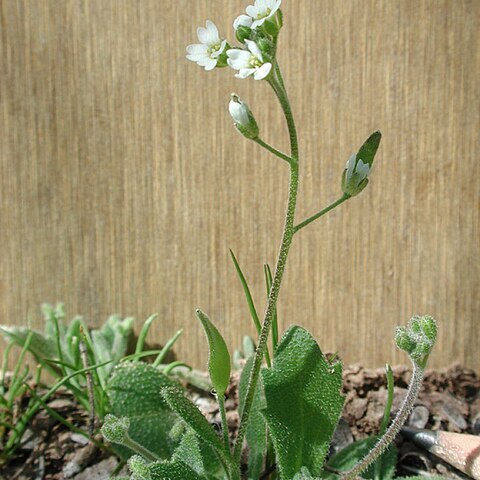Annuals; scapose or subscapose. Stems (simple to many from or near base), unbranched, (0.2-) 0.3-2.7(-3.7) dm, hirsute or pubescent throughout, trichomes 3-4-rayed, 0.05-0.4 mm, (sometimes mixed proximally with simple or spurred ones, 0.5-1.2 mm). Basal leaves not rosulate; petiole (obscure), not ciliate; blade oblanceolate to spatulate or broadly obovate, (0.4-)1-3.5(-5) cm × (2-)6-20(-28) mm, margins dentate (in distal 1/2), surfaces pubescent, abaxially with stalked, 2-4-rayed trichomes, 0.1-0.7 mm, adaxially similar or also with fewer, simple trichomes, 0.4-0.7 mm. Cauline leaves 0-6 (on proximal 1/3 of stem); blade similar to basal. Racemes 10-50(-70)-flowered (throughout or on distal 1/3 of scape), ebracteate, elongated in fruit; rachis not flexuous, densely pubescent, trichomes 2-4-rayed. Fruiting pedicels horizontal to divaricate-ascending, straight, (1-)2-7(-10) mm, pubescent as rachis. Flowers: (late ones cleistogamous, apetalous); sepals (green or pink), oblong, 1.5-2.5 mm, glabrous or pubescent, (trichomes simple); petals white, spatulate, (2-)2.5-4.5(-5) × 1-2 mm, (emarginate or obtuse); anthers ovate to oblong, (0.1-)0.25-0.4 mm. Fruits oblong to linear or lanceolate to broadly ovate, plane, flattened, (3-) 6-12(-16) × 1.7-2.7(-3) mm; valves usually puberulent, rarely glabrous, trichomes simple, antrorse, 0.1-0.3 mm, (rarely with 2-rayed ones, or all trichomes short-stalked, 4-rayed, cruciform); ovules (12-)24-66 (-72) per ovary; style 0.01-0.3(-0.4) mm. Seeds broadly ovoid, 0.5-0.7 × 0.4-0.5 mm. 2n = 30, 32.
More
Annual or winter-annual, 1–2.5 dm, simple or branched at the base; basal lvs oblanceolate to narrowly obovate, 1–3 cm, coarsely dentate, rough-hairy; cauline lvs few and only near the base; pet white, to 4 mm, or none; mature racemes 5–10 cm, the axis and divaricate pedicels pubescent; pedicels half as long to equaling the fr; frs widely spreading, narrowly elliptic, 6–11 mm, blunt, minutely strigulose; 2n=32. Dry woods and barrens; Ill., Ky., and Mo., w. and s. to Calif. and n. Mex.; Fla. May.

